1997 Central European flood
The 1997 Central European flood or the 1997 Oder Flood of Oder and Morava river basins in July 1997 affected Poland, Germany, and Czech Republic, taking lives of about 74 people[1][2] (in Czech Republic and Poland) and causing material damages estimated at $4.5 billion (3.8 billion euros in Czech Republic and Poland and 330 million euros in Germany). The flooding began in Czech Republic, then spread to Poland and Germany. In Poland, where it was one of the most disastrous floods in history of that country,[3][4] it was named the Millennium Flood (Powódź tysiąclecia).[4] The term was also used in Germany (Jahrtausendflut).[5] The flood has also been referred to as the Great Flood of 1997.[4][6]
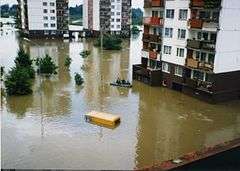 Kozanów residential district in Wrocław, Poland during the flood | |
| Date | July 1997 |
|---|---|
| Location | Czech Republic, Poland, Germany |
| Deaths | 114 (56 in Poland, 58 in the Czech Republic) |
| Property damage | $4.5 billion |
Causes
Southwestern Poland and the northern Czech Republic experienced two periods of extensive rainfall, first occurring 3–10 July and second 17–22 July.[4][7] The precipitation was caused by a Genoa low pressure system, which moved from northern Italy to Moravia and Poland. The unusual development occurred when a field of higher air pressure between the Azores Islands and Scandinavia was blocked. The center of low pressure remained over southern Poland for a long period of time.[4]
The precipitation was very high, measuring 300–600 millimetres (12–24 in), and corresponded to several months' average rainfall over a few days.[3] Water levels rose 2–3 m above previously recorded averages[3] and were so high that they caused the water to flow over existing measurement poles. It was one of the heaviest rainfalls in recorded world's history.[6] It was dubbed the Millennium Flood because a likelihood of such a flood in a particular year was estimated at 0.1%.[8] [9]
Floods
-powodz_1997.jpg)
Flooding began on 5 July in the Czech Republic and spread to Poland on 6 July. Those early floods were very rapid flash floods (water levels rose by up to four meters in half a day).[4] In Poland, the first towns flooded were located around Głuchołazy, and were visited by Polish Prime Minister Włodzimierz Cimoszewicz on 7 July.[6] Flooding spread rapidly from Chałupki to Racibórz. In Kłodzko several buildings dating back a few hundred years (kamienica) collapsed; on 8 July the flood reached Krapkowice. In the second stage of the flood, the flood wave flowed down through the Oder river, submerging successive towns in the area.[4] Left-bank Opole was flooded on 10 July, Wrocław and Rybnik on 12 July, and Głogów soon after. The rising waters slowed by the time they reached the Polish-German border (the Oder-Neisse line), allowing more time for preparations; the damages were thus much lower.[4]
On 18 July, Polish president Aleksander Kwaśniewski declared a day of national mourning.[10]
Water levels


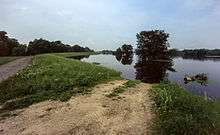
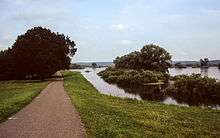
Water levels recorded on the Oder river in the flood period:[11]
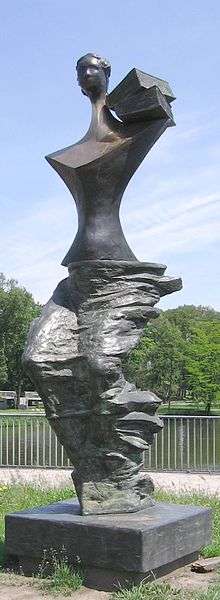
| Location | Oder-km | Maximum water level [cm] | Date |
|---|---|---|---|
| Poland Racibórz Miedonia | 55.5 | 1045 | 9 July 1997 |
| Poland Ujście Nysy | 180.5 | 768 | 10 July 1997 |
| Poland Rędzin | 261.1 | 1030 | 13 July 1997 |
| Poland Brzeg Dolny | 284.7 | 970 | 13 July 1997 – 14 July 1997 |
| Poland Malczyce | 304.8 | 792 | 14 July 1997 – 15 July 1997 |
| Poland Ścinawa | 331.9 | 732 | 15 July 1997 |
| Poland Głogów | 392.9 | 712 | 16 July 1997 |
| Poland Nowa Sól | 429.8 | 681 | 16 July 1997 |
| Poland Cigacice | 471.3 | 682 | 19 July 1997 |
| Poland Połęcko | 530.3 | 595 | 24 July 1997 |
| Germany Ratzdorf | 542.5 | 691 | 24 July 1997 |
| Germany Eisenhüttenstadt | 554.1 | 717 | 24 July 1997 |
| Germany Frankfurt/Oder | 584.0 | 657-656 | 27 July 1997 |
| Poland Słubice | 584.1 | 637 | 27 July 1997 |
| Germany Kietz | 614.8 | 653 | 27 July 1997 – 28 July 1997 |
| Germany Kienitz | 633.0 | 628 | 24 July 1997 |
| Poland Gozdowice | 645.3 | 659 | 31 July 1997 – 1 July 1997 |
| Germany Hohensaaten-Finow | 664.9 | 729 | 31 July 1997 |
| Germany Hohensaaten Ostschleuse OP (Oderseite) |
667.2 | 805 | 31 July 1997 |
| Poland Bielinek | 673.5 | 712 | 31 July 1997 – 1 August 1997 |
| Germany Stützkow | 680.5 | 1009 | 29 July 1997 |
| Germany Schwedt Oderbrücke | 690.6 | 886 | 2 August 1997 |
| Germany Schwedt Schleuse OP (Oderseite) |
697.0 | 840 | 1 August 1997 – 2 August 1997 |
| Poland Widuchowa | 701.8 | 760 | 2 August 1997 – 3 August 1997 |
| Germany Gartz (Oder) | 8.0 | 698 | 1 August 1997 – 2 August 1997 |
| Germany Mescherin | 14.1 | 672 | 3 August 1997 |
| Poland Gryfino | 718.5 | 649 | 3 August 1997 |
| Germany Ückermünde | Oderhaff | 536 | 6 August 1997 |
Fatalities and damages
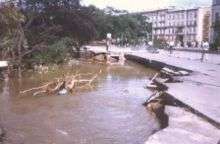
The flood caused the deaths of 114 people (56 in Poland,[12][13] 58 in the Czech Republic[14][15]) and material damages estimated at $4.5 billion[16] (3.8 billion euros in the Czech Republic and Poland and 330 million euros in Germany).
In Poland, it is estimated that 7,000 people lost all of their possessions. 9,000 private businesses were affected and 680,000 houses were damaged or destroyed. The flood also damaged 843 schools (100 destroyed), 4,000 bridges (45 destroyed), 14,400 km of roads, 2,000 km of railways. In total, 665,835 hectares were affected in Poland (an estimated 2% of Polish total territory).[3][17] The losses were estimated at 63 billion Polish zloties (or US$2.3–3.5 billion at the 1997 levels[3]). The town of Kłodzko sustained damages equivalent to 50 years of its annual budget.[4][4]
In the Czech Republic, there were 50 fatalities[6] (another source gives 60[15]). 2151 flats and 48 bridges were destroyed.[18] 538 villages and towns were affected.[6] The losses were estimated at 63 billion Czech korunas.[6] The town of Troubky was most severely affected.
In Germany there were no fatalities.[19]
Responses
Government responses in Czech Republic and Poland were criticized.[6] The flood revealed various inadequacies in decision making and infrastructure, although the unprecedented magnitude of the disaster was seen by some as a mitigating factor.[3][4]
Numerous charities provided aid to those affected by the floods.[20]
See also
References
- "Third dike bursts in flood-hit Germany". CNN. 25 July 1997. Retrieved 25 September 2014.
- International Commission on the Protection of the Oder against Pollution (1999): 1997 flood. Oder catchment area, Wrocław ()
- Roman Konieczny. Paweł Madej. Małgorzata Siudak. Local Flood Hazard Reduction Plans in Poland – Problems and Perspectives. In Eve Gruntfest; John Handmer (2001). Coping with flash floods. Springer. p. 91. ISBN 978-0-7923-6826-7.
- Zbigniew W. Kundzewicz. Summer 1997 Flood in Poland in Perspective. In Oleg Fedorovich Vasilʹev; North Atlantic Treaty Organization; E. J. Plate; M. V. Bolgov (2007). Extreme Hydrological Events: New Concepts for Security. Springer. p. 98. ISBN 978-1-4020-5740-3.
- Martin Doring. The Politics of Nature: Constructing the German Reunification during the Great Odra Flood 1997 in Riyan J. G. van den Born; W. T. de Groot; Rob H. J. Lenders (2006). Visions of nature: a scientific exploration of people's implicit philosophies regarding nature in Germany, the Netherlands and United Kingdom. LIT Verlag Münster. p. 155. ISBN 978-3-8258-9008-7.
- K. Szamalek. The Great Flood of 1997 in Poland: The Truth and Myth. In Geoffrey E. Petts; C. Amoros (1996). Fluvial hydrosystems. Springer. p. 67. ISBN 978-0-412-37100-4.
- (in German) Studien und Tagungsberichte, Schriftenreihe des Landesumweltamtes Brandenburg. Band 16 – Das Sommerhochwasser an der Oder 1997 – Fachbeiträge anläßlich der Brandenburger Ökologietage II. Potsdam. Marz 1997
- (in Polish) Przemysław Berg, Czy grozi nam powódź: Widmo Wielkiej Wody, Polityka, 21 lutego 2010
- Goniewicz, Krzysztof; Burkle, Frederick M. (2019). "Challenges in Implementing Sendai Framework for Disaster Risk Reduction in Poland". International Journal of Environmental Research and Public Health. 16 (14): 2574. doi:10.3390/ijerph16142574. PMID 31323878.
- (in Polish) Zarządzenie Prezydenta Rzeczypospolitej Polskiej z dnia 15 lipca 1997 r. w sprawie opuszczenia flagi państwowej Rzeczypospolitej Polskiej. M.P. 1997 nr 42 poz. 423
- Studien und Tagungsberichte, Schriftenreihe des Landesumweltamtes Brandenburg. Band 16 – Das Sommerhochwasser an der Oder 1997 – Fachbeiträge anläßlich der Brandenburger Ökologietage II. Potsdam. Marz 1997
- (in Polish) ZBIGNIEW W. KUNDZEWICZ, MACIEJ ZALEWSKI, ANDRZEJ KĘDZIORA, EDWARD PIERZGALSKI, Zagrożenia związane z wodą Archived 7 October 2011 at the Wayback Machine, NAUKA 4/2010 • 87–96
- Zbigniew W. Kundzewicz. Summer 1997 Flood in Poland in Perspective. In Oleg Fedorovich Vasilʹev; North Atlantic Treaty Organization; E. J. Plate; M. V. Bolgov (2007). Extreme Hydrological Events: New Concepts for Security. Springer. p. 102. ISBN 978-1-4020-5740-3.
- Pavel Punchchar, Marek Mata, and Daniel Pokorny. Improvement of Flood Protection in Czech Republic in Geoffrey E. Petts; C. Amoros (1996). Fluvial hydrosystems. Springer. p. 17. ISBN 978-0-412-37100-4.
- Jaromir Riha. Dams and floods in the Czech Republic. In L. Berga (2006). Dams and Reservoirs, Societies and Environment in the 21st Century: Proceedings of the International Symposium on Dams in the Societies of the 21st Century, 22nd International Congress on Large Dams (ICOLD), Barcelona, Spain, 18 June 2006. Taylor & Francis. p. 193. ISBN 978-0-415-40423-5.
- Jochen Schanze; Evzen Zeman; Jiri Marsalek (2006). Flood risk management: hazards, vulnerability and mitigation measures. Springer. p. 22. ISBN 978-1-4020-4597-4.
- (in Polish) Jerzy Grela, Henryk Słota, Jan Zieliński (editors). 1999. Dorzecze Wisły. Monografia Powodzi lipiec 1997. Instytut Meteorologii i Gospodarki Wodnej. ISBN 83-85176-68-3
- Axel Bronstert (August 1999). Proceedings of the European Expert Meeting on the Oder Flood 1997: 18 May 1998, Potsdam, Germany : Ribamod concerted action. Office for Official Publications of the European Communities. ISBN 978-92-828-6073-1.
- Wilhelm Kirch; Bettina Menne; Roberto Bertollini (2005). Extreme weather events and public health responses. Birkhäuser. p. 202. ISBN 978-3-540-24417-2.
- Jeffrey K. Johnson (2009). American advertising in Poland: a study of cultural interactions since 1990. McFarland. p. 155. ISBN 978-0-7864-3797-9.
External links
![]()